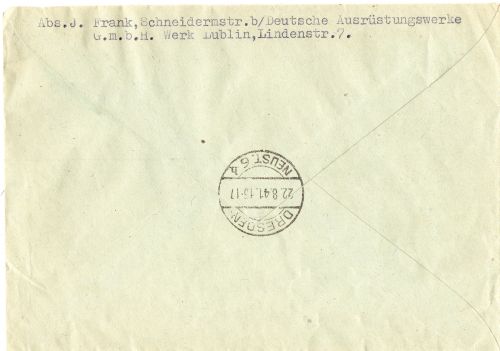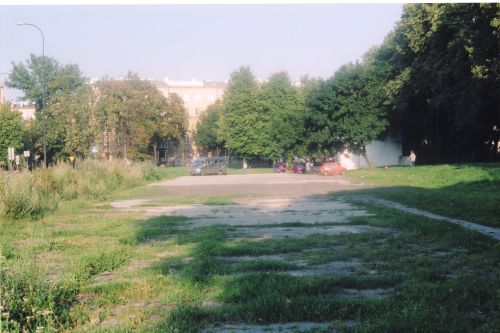Jakob Frank - Lipowa Street

Correspondence from J.Frank DAW, Lublin to Dresden- Envelope Reverse (Chris Webb Private Archive)
Jacob Frank was nearly twenty-eight years-old when Odilo Globocnik arrived in Lublin to take up his post of SS and Police Leader of the Lublin District in November 1939. Within six months Frank found himself working in the first of Globocnik's major work camps located at Lipowa Street 7, virtually in the centre of Lublin, near the cemetery.
Lipowa Street camp remained fully operational from 1940, until it was closed in November 1943, as part of the Aktion Erntefest mass murder, where the inmates were marched to the Lublin Concentration Camp on the outskirts of the city, and shot in mass trenches within the camp.
Frank's account of his wartime years is a valuable source for a number of reasons, not least because he was in the Lipowa Street camp from its inception to virtually the end of its operational life. Furthermore he was a native of Lublin, and thus observed all the developments and changes in Lipowa Camp that the Jewish Prisoners of War from camps in Germany, would simply been unable to do. In addition Jacob Frank was the SS -designated supervisor of the camp's important tailoring division and was in charge of circa 475 workers, though not all were qualified tailors. As a result, he had close contact with senior SS men, who oversaw the running of the camp or its working and production divisions. He even had a number of opportunities to observe Globocnik from fairly close quarters.
Frank's account begins prior to the Lipowa Street camp being established, along with circa 10,000 other Jews within the Lublin District, he decided after consulting with other members of his family to move to the Soviet-occupied sector of Eastern Poland, and he remained there for two and a half months, living with a Polish family, he had known from before the Second World War. But he finally decided that he would prefer to be with his family, which included his parents and siblings, his wife and two sons.
Prior to fleeing East, Jacob Frank had undergone a two-day registration ordeal, conducted by the SS. All of Lublin's male Jews, aged between 12 to 60 years old, were forcibly assembled for some 48 hours on the site that later became the Lipowa Street camp, for this harsh and humiliating police action. Shortly after his return from his 10-week stay in Soviet -occupied Poland, he and four other Lublin Jewish tailors were taken to SS headquarters where they were told in no uncertain terms to form a tailoring contingent for the SS. Jacob Frank was instructed at the time, that he would become the leader of a tailoring workshop.
At the same time, Lublin's Jewish Council (Judenrat) was formally advised by SS- Untersturmfuhrer Horst Riedel, who later would serve as Commandant at the Lipowa Street camp, that tailoring workshops were to be erected on a vast expanse of land that was to become the site of the Lipowa Street camp. This order meant that the Jewish community of Lublin had to first collect the necessary tools of the trade, as well as provide the workforce to undertake this task, while the tailors, and later Jewish shoemakers, had to provide their own sewing machines, scissors, irons, needles, and other essential equipment to run Riedel's proposed workshops.
Shortly afterwards, Frank learned from the vice president of the Lublin Judenrat, Salomon Kestenberg, that the SS were calling for 100 tailors, with an order being issued to this effect. The order was eventually fulfilled by the threat of intervention by the Jewish police force, on orders by the SS. This was the method employed often by Globocnik, orders having to be obeyed without delay, no matter how onerous or outrageous.
Horst Riedel gave Frank his daily order to go to the SS headquarters to collect the uniforms from the SS-Brigadefuhrer Globocnik and from the SS officers who served him. Frank was required to carry this out at 8 A.M. daily, with two other tailors. This group collected all the uniforms that needed cleaning and pressing. At this time, however, members of the Lipowa tailoring workforce were still living with their families in the Lublin Ghetto. Because Frank was a divisional supervisor, he had a special pass - one signed by Globocnik - which gave him considerable freedom of movement, as well as relatively close ongoing contacts with the new camp's SS commanders. Frank also lived under better conditions than his staff members. He described Lipowa Camp as having either four or five separate blocks, with the perimeter being guarded by troops in towers, armed with machine-guns.
The site of Lipowa Street camp originally consisted of several horse stables. At the turn of 1939-1940, however, a barbed wire fence enclosed it, with the guard towers added in March 1940. Horst Riedel's assistant Wolfgang Mohwinkel, who became his successor, was an engineer and still in his 20's. He designed the camp, including the layout of its barracks. Sanitary conditions were appalling and the treatment of the inmates grew steadily worse, this included beatings and executions, with little pretext or provocation on the part of the prisoners.
Lipowa Street camp was sealed in late 1941, so its craftsmen and other inmates were isolated from their families. After the Lublin Ghetto was liquidated in March -April 1942, the inmates of the Lipowa Street camp were left permanently isolated because their families had been removed and killed either in death camps of Belzec and Sobibor.

Lublin - Site of the former Lipowa Camp Site - July 2004 - (Chris Webb Private Archive)
The camp was an establishment that Globocnik was clearly proud of, because he regularly showed its workshops to visiting Nazi dignitaries from Berlin and elsewhere, including in the summer of 1941, to his superior Heinrich Himmler. Jacob Frank also recalled an inspection in 1942, that involved Adolf Eichmann, who was chaperoned by Globocnik, Maubach, Mohwinkel, Schramm, Klein, Hantke, and the Standartenfuhrer von Alvensleben.
Frank said that most of the Lipowa Street camp inmates were in their 20's and tended to be markedly fitter and healthier than those in other camps, where the age structure in all likelihood more closely reflected society at large. Frank believed that because of this most could have survived until the Red Army drove the German's out in the summer of 1944, something they were denied by the Aktion Erntfest massacre in November 1943.
But it was not Frank's age and physical fitness that saved him. He was spared from the clutches of the Aktion Erntefest murders, because of his known reputation as a fine tailor, who sewed excellent leather coats. Just before the massacres took place on November 3, 1943, Frank was transferred to a prison in Lublin, because Globocnik, who had been recently transferred to Trieste, wished to have his still unfinished leather coat completed. This lucky turn of events meant Frank was deliberately removed from Lipowa to complete this task. In a bizarre way, Globocnik's requirement - his desire to have a leather coat just like Heinrich Himmler and other senior SS leaders- actually saved Frank's life.
The prison's commandant, a man Frank recalled having the name Dominik spoke to Frank:
'After a few seconds he told me, 'I have an order from Obergruppenfuhrer Globocnik to help you here, and here you are safe. But I have also a package. I'm sure you have this upstairs. This is the coat for the Obergruppenfuhrer, and we have here a shop for tailors. I set up a place for you, and if you need some help, you tell me, and I'll give you all the help that you want from the other tailors what are there in the prison with you.'
Frank makes no reference to the completion of Globocnik's leather coat, but it is safe to assume the prized garment was delivered to Odilo Globocnik in Trieste. In late June or early July 1944, with the Red Army approaching Lublin, Jacob Frank was transferred to Radom, where he was incarcerated in a Labour Camp holding circa 3,000 Jewish men, women and children.
According to Frank himself, all the inmates of this Labour Camp in Radom during August 1944, were forced to embark on a death-march to Tomaszow Mazowiecki. Some 1,800 survivors of this death-march spent three days in a deserted flour mill, before being taken by rail to Auschwitz, where the women and children were off-loaded, whilst the remainder of the transport went further west to a sub-camp of the Natzweiler Concentration Camp, Vahingen, in the Stuttgart region of Germany.
After being at Vaihingen, until March 1945, where he worked underground bomb-proof facility, Frank was once again moved to the Dachau Concentration Camp, where he was eventually liberated from in May 1945.
Sources
Joseph Poprzeczny, Hitler's Man in the East Odilo Globocnik,, McFarland & Company Inc, Jefferson, 2004
Envelope and Photograph: Chris Webb Private Archive
© Holocaust Historical Society March 25, 2021

